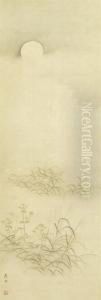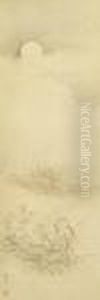Ozui Maruyama Paintings
Ozui Maruyama was a prominent Japanese painter born in 1773 and part of the esteemed Maruyama School of Japanese painting, which played a pivotal role in the development of the Shijō style, blending the naturalistic depiction of subjects with a more expressive, individualistic approach. He was the eldest son of Maruyama Ōkyo, the founder of the Maruyama school in Kyoto, which significantly influenced the trajectory of Japanese art by integrating Western realism with traditional Eastern styles.
Ozui's work, while deeply rooted in the teachings of his father, also exhibited a distinct personal style that contributed to the evolution of the Maruyama school's aesthetic. He was known for his detailed and realistic landscapes and nature studies, which showcased not only his technical prowess but also his profound appreciation of the natural world. His paintings often depicted the serene beauty of Japan's countryside, its flora and fauna, with a remarkable level of detail and a delicate touch that was characteristic of the Maruyama-Shijō movement.
Throughout his career, Ozui worked to further the integration of Western techniques into Japanese painting, experimenting with perspective and shading to create depth and realism in his works. Despite his achievements and contributions to Japanese art, Ozui's legacy is often overshadowed by the towering figure of his father, Maruyama Ōkyo. Nonetheless, art historians and enthusiasts recognize Ozui Maruyama's role in carrying forward and enriching the Maruyama School's tradition, blending the observational rigor of Western art with the spiritual and aesthetic sensibilities of Japanese tradition.
Ozui Maruyama's death in 1829 marked the end of an era for the Maruyama School, but his influence persisted, inspiring future generations of artists to explore and innovate within the realm of Japanese painting. His works remain celebrated for their beauty and technical skill, and they continue to be studied for their contribution to the development of the Shijō style, which emphasized the importance of personal expression within the confines of traditional Japanese painting techniques.

